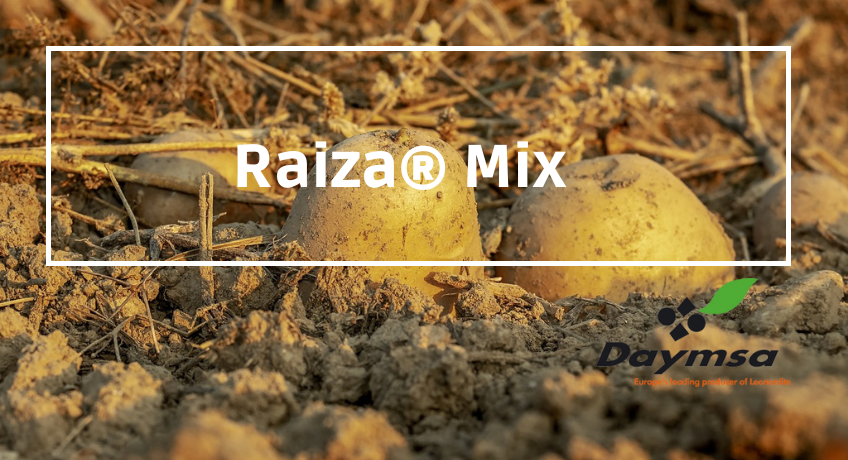
Raiza Mix, higher yield and quality in potato crops
Daymsa has carried out a study on seed treatment with Raiza® Mix to analyse the yield and quality of potato production.
Potatoes are one of the most water demanding crops. It needs to have constant availability of this resource to ensure the yield and quality of the tubers, but at the same time it requires well-drained soils to avoid prolonged waterlogging.
During the growing cycle, the potato plants are exposed to the action of a series of pests and diseases, of various origins, which appear during a long period of time, from planting to the end of the vegetative phase. Among the main pests and diseases affecting this crop are the Guatemalan potato moth (Tecia solanivora), the potato flea (Epitrix similars) or the zebra chip (Candidatus Liberibacter solanacearum), the latter usually appearing through invasive insects.
The occurrence of these pests is mainly due to the relatively long period of tuber development in the soil. On the other hand, unfavourable climatic conditions in the period of emergence and subsequent growth of potato plants may be another factor in the occurrence of these pests.
Trials carried out with Raiza® Mix
Daymsa has carried out trials with Raiza® Mix on two potato varieties: Hermes, a Dutch potato, edible, semi-early and useful for the production of French fries, and Tajfun, a medium-early variety that produces large, almost perfectly oval tubers with a slightly yellow skin.
The treatment was carried out a few hours before planting by soaking the potato seeds for 5 minutes in a 0.66% solution, i.e. 0.2 l of Raiza® Mix was dissolved in 30 l of water. The trial was carried out in a light acid soil in a year characterised by an excess of rainfall (134.6 mm above the average of several years) and a significantly different air temperature during the vegetative growing season.
Results
After the application of the 0.66% Raiza® Mix treatment, the Hermes variety achieved an increase in tuber yield of 4.2 t/ha, i.e. 9.9% more than the control, and for the Tajfun variety 4.9 t/ha, i.e. 10.3% more than the control, as shown in the following graphs.
Graph 1. Raiza® Mix effect on the yield of potato variety Hermes
| Yield potato (t/ha) | Yield increase (t/ha) | Increase in performance (%) | |
| Control (without treatment) | 42,6 | – | 100,0 |
| Raiza® Mix (0,66% solution) | 46,8 | 4,2 | 109,9 |
Graph 2. Raiza® Mix on yield of potato Tajfun variety
| Yield potato (t/ha) | Yield increase (t/ha) | Increase in performance (%) | |
| Control (without treatment) | 47,7 | – | 100,0 |
| Raiza® Mix (0,66% solution) | 52,6 | 4,9 | 110,3 |
On the other hand, seed potato treatment with Raiza® Mix also improved the diameter distribution of the tubers produced, which increased the proportion of tubers with a diameter of 35-50 mm for both varieties compared to the control.
Raiza® Mix also contributed to increase in the starch and dry matter content of the tubers compared to the control. The level of nitrate in the tubers was relatively low as shown in the tables below. Regarding the vitamin C content in the fruits, an increase of 20% was achieved in the Tajfun variety, compared to the control treatment.
Graph 3. Effect of Raiza® Mix on the composition of tubers of the Hermes variety
| Starch (%) | Nitrate (mg/kg) | Vitamin C (mg/kg) | Dry matter (%) | |
| Control (without treatment) | 16,0 | 27 | 131,1 | 22,1 |
| Raiza® Mix (0,66% solution) | 16,5 | 34 | 127,7 | 22,6 |
Graph 4. Effect of Raiza® Mix on the composition of Tajfun variety tubers.
| Starch (%) | Nitrate (mg/kg) | Vitamin C (mg/kg) | Dry matter (%) | |
| Control (without treatment) | 15,9 | 28 | 112,5 | 22,1 |
| Raiza® Mix (0,66% solution) | 16,4 | 35 | 134,5 | 22,5 |
Conclusions
The tests carried out showed that after the application of Raiza® Mix on potato seed, great benefits such as increased yield or improved tuber quality were reflected.
In this sense, the application of this product on potato seed stimulated root development and improved nutrient absorption after sowing, favouring uniform germination, vigorous and stress-resistant plants, and helping the crop to reach its maximum productive potential.
